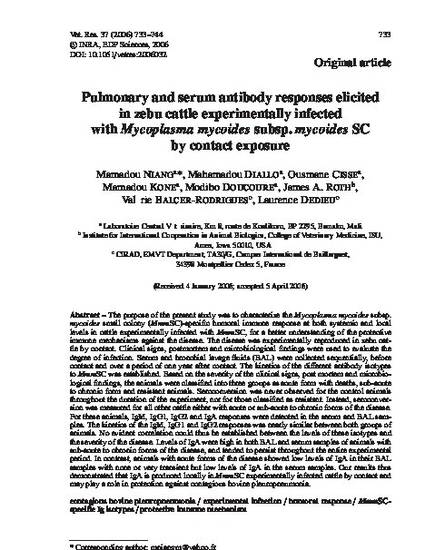
The purpose of the present study was to characterize the Mycoplasma mycoides subsp. mycoides small colony (MmmSC)-specific humoral immune response at both systemic and local levels in cattle experimentally infected with MmmSC, for a better understanding of the protective immune mechanisms against the disease. The disease was experimentally reproduced in zebu cattle by contact. Clinical signs, postmortem and microbiological findings were used to evaluate the degree of infection. Serum and bronchial lavage fluids (BAL) were collected sequentially, before contact and over a period of one year after contact. The kinetics of the different antibody isotypes to MmmSC was established. Based on the severity of the clinical signs, post mortem and microbiological findings, the animals were classified into three groups as acute form with deaths, sub-acute to chronic form and resistant animals. Seroconversion was never observed for the control animals throughout the duration of the experiment, nor for those classified as resistant. Instead, seroconversion was measured for all other cattle either with acute or sub-acute to chronic forms of the disease. For these animals, IgM, IgG1, IgG2 and IgA responses were detected in the serum and BAL samples. The kinetics of the IgM, IgG1 and IgG2 responses was nearly similar between both groups of animals. No evident correlation could thus be established between the levels of these isotypes and the severity of the disease. Levels of IgA were high in both BAL and serum samples of animals with sub-acute to chronic forms of the disease, and tended to persist throughout the entire experimental period. In contrast, animals with acute forms of the disease showed low levels of IgA in their BAL samples with none or very transient but low levels of IgA in the serum samples. Our results thus demonstrated that IgA is produced locally in MmmSC experimentally infected cattle by contact and may play a role in protection against contagious bovine pleuropneumonia.
Available at: http://works.bepress.com/james_roth/29/

This article is from Veterinary Resarch 37 (2006): 733, doi:10.1051/vetres:2006032. Posted with permission.